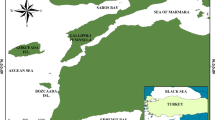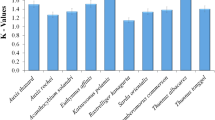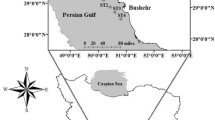Abstract
The paper mentioned was applied using the fish samples obtained by commercial fishermen using gillnets through the stationary set and drive in fishing methods in order to search out length-girth relationships (LGRs) of blotched picarel (Spicara maena (Linnaeus, 1758)), picarel (Spicara smaris (Linnaeus, 1758)) and mediterranean rainbow wrasse (Coris julis (Linnaeus, 1758)) between January 2021 and December 2021 in the Saros Bay (northern Aegean Sea, Türkiye). The opercular girth-length relationships were calculated as Gope = 0.7176TL – 3.4105 (r2 = 0.89), Gope = 0.5579TL – 2.4407 (r2 = 0.89) and Gope = 0.9118TL – 7.3585 (r2 = 0.93), whilst the maximum girth-length relationships were estimated as Gmax = 0.9124TL – 4.7124 (r2 = 0.82), Gmax = 0.5874TL – 1.2491 (r2 = 0.80) and Gmax = 1.0227TL – 8.6218 (r2 = 0.95) for Spicara maena, Spicara smaris and Coris julis, respectively. All linear regressions of this research were statistically notable (p < 0.001). The existing research involves the first findings of LGRs of Spicara smaris for the North Aegean Sea, whilst any LGRs values of Coris julis have in days of yore been not reported worldwide, but the paper mentioned. Since the relevant valuates are remarkable for development the selectivity of fishing equipments in order to forestall the seize of immature, undersized, younger fish, it will bolster the advancement of the ecosystem-based fisheries management.




Similar content being viewed by others
Data Availability
All data in present paper have been given as figures and tables.
References
Adamidou A, Touloumis K, Tsikliras A (2021) Length-girth relationships of 24 marine fishes in the northern Aegea Sea (Eastern Mediterranean Sea). Acta Adriat 62(2):219–236. https://doi.org/10.32582/aa.62.2.351
Antoine D, Morel A, André JM (1995) Algal pigment distribution and primary production in the eastern Mediterranean as derived from coastal zone color scanner observations. J Geophys Res 100(C-8):16193–16209. https://doi.org/10.1029/95JC00466
Baranov FI (1948) Theory of fishing with gill nets. In: Baranov FI (ed) Theory and assessment of fishing gear. Pishchepromizdat, Moscow, p 45
Beğburs CR, Babaoğlu AÖ, Kara A, İlkyaz AT (2020) Length-girth and length-weight relationships of 13 fish species from Izmir Bay (Turkey). Fresenius Environ Bull 29:8104–8108
Cengiz Ö (2021) Opercular girth, maximum girth and total length relationships for eight fish species from the Saros Bay (Northern Aegean Sea, Turkey). Palawan Sci 13(2):25–36
Cengiz Ö (2022) Relationships between opercular girth, maximum girth and total length of six sparid fishes from Saros Bay (Northern Aegean Sea, Turkey): An assessment for ecosystem-based fisheries management. Philipp Agri Sci 105(3):247–254
Cengiz Ö (2023) Length-girth relations of five sparid fishes off Gökçeada Island, Northern Aegean Sea, Turkey. Thalassas 39(1):7–13. https://doi.org/10.1007/s41208-022-00508-3
Cengiz Ö, Paruğ ŞŞ (2022) Relationships between opercular girth and maximum girth, total weight, total length of atlantic bonito (Sarda sarda Bloch, 1793), atlantic mackerel (Scomber scombrus Linnaeus, 1758) and atlantic chub mackerel (Scomber colias Gmelin, 1789) from Gallipoli Peninsula (Northern Aegean Sea, Turkey). KSU J Agric Nat 25 (Suppl 1):251–261. https://doi.org/10.18016/ksutarimdoga.vi.1039433
Cengiz O, Ayaz A, Oztekin A, Kumova C (2013) Determination of the selectivity of multifilament gillnets used for catching the bogue (Boops boops Linnaeus, 1758) by length-girth relationships in Gallipoli Peninsula (Northern Aegean Sea, Turkey). Menba J Fish Faculty 1(1):28–32
Cengiz Ö, İşmen A, Özekinci U (2014) Reproductive biology of the spotted flounder, Citharus linguatula (Actinopterygii: Pleuronectiformes: Citharidae), from Saros Bay (northern Aegean Sea, Turkey). Acta Ichthyol Piscat 44(2):123–129. https://doi.org/10.3750/AIP2014.44.2.06
Cengiz Ö, İşmen A, Özekinci U, Öztekin A (2015) Some reproductive characteristics of four-spotted megrim (Lepidorhombus boscii Risso, 1810) from Saros Bay (Northern Aegean Sea, Turkey). J Agric Sci 21(2):270–278
Daliri M, Paighambari SY, Shabani MJ, Pouladi M, Davoodi R (2012) Length-weight and length-girth relationships, relative weight and relative condition factor of four commercial fish species of northern Persian Gulf. Annu Res Rev Biol 2:15–26
Ecoutin JM, Albaret JJ (2003) Length-weight relationship of 52 fish species from West African estuaries and lagoons. Cybium 27(1):3–9
Eronat C, Sayın E (2014) Temporal evolution of the water characteristics in the bays along the eastern coast of the Aegean Sea: Saros, İzmir, and Gökova bays. Turk J Earth Sci 23(1):53–66. https://doi.org/10.3906/yer-1307-4
Fujimori Y (2018) A new approach of determining gillnet selectivity based on the relationship between fish length and girth to estimate the length distribution of fish encountering a net. Bull Fish Sci Hokkaido Uni 68(1):1–6. https://doi.org/10.14943/bull.fish.68.1.1
Gabr MH, Mal AO (2018) Trammel net fishing in Jeddah: species composition, relative importance, length-weight and length-girth relationships of major species. Int J Fish Aquat Stud 6:305–313
Gönülal O, Dalyan C (2017) Deep-sea biodiversity in the Aegean Sea. In: Mediterranean identities - environment, society, culture. IntechOpen, Bjelovar, pp 149–178. https://doi.org/10.5772/intechopen.70492
Güçlüsoy H (2015) Marine and coastal protected areas of Turkish Aegean coasts. In: Katağan T, Tokaç A, Beşiktepe Ş, Öztürk B (eds) The Aegean Sea Marine Biodiversity, Fisheries, Conservation and Governance. Turkish Marine Research. Publication no: 41. Foundation (TUDAV), Istanbul, Turkey, pp 669–684
Hambright KD (1991) Experimental analysis of prey selection by largemouth bass: role of predator mouth width and prey body depth. Trans Am Fish Soc 120(4):500–508. https://doi.org/10.1577/1548-8659(1991)120<0500:EAOPSB>2.3.CO;2
Hamley JM (1975) Review of gillnet selectivity. J Fish Res Board Can 32(11):1943–1969. https://doi.org/10.1139/f75-233
Jawad LA, Mc Kenzie U, Al-Noor SS (2009) Relationship between opercular girth, maximum girth and total length of fishes caught in gillnets in the estuarine and lower river sections of Shatt al-Arab River (Basrah Province, Iraq). J Appl Ichthyol 25(4):470–473. https://doi.org/10.1111/j.1439-0426.2009.01254.x
Jawad L, Bobori D, Al-Shwikh H, Al-Saleh F (2015) Opercular girth maximum girth and total length relationships for Planiliza abu (Heckel, 1843) and Chondrostoma regium (Heckel, 1843) (Actinoprerygii) from Euphrates River at Dier Ez-Zor Governorate, Syria. Acta Zool Bulg 67(4):591–594
Kawamura G (1972) Gill-net mesh selectivity curve developed from length-girth relationship. Nippon Suisan Gakkai Shi 38(10):1119–1127. https://doi.org/10.2331/suisan.38.1119
Kurkilahti M, Appelberg M, Hesthagen T, Rask M (2002) Effects of fish shape on gillnet selectivity: a study with Fulton’s condition factor. Fish Res 54(2):153–170. https://doi.org/10.1016/S0165-11787836(00)00301-5
Kyritsi S, Mantzouni I, Moutopoulos DK (2018) Length-girth relationships for freshwater fishes from Lake Volvi (Northern Greece). Int J Fish Aquat Stud 6:231–234
Lucena FM, O'Brien CM, Reis EG (2000) The effect of fish morphology and behaviour on the efficiency of gill nets, their selectivity and by-catch: two examples from southern Brazil. ICES CM 2000/J:11
Maravelias CD, Papaconstantinou C (2006) Geographic, seasonal and bathymetric distribution of demersal fish species in the eastern Mediterranean. J Appl Ichthyol 22(1):35–42. https://doi.org/10.1111/j.1439-0426.2006.00695.x
McCombie AM, Berst HA (1969) Some effects of shape and structure of fish on selectivity of gillnets. J Fish Res Board Can 26(10):2681–2689. https://doi.org/10.1139/f69-2601189
Mendes B, Fonseca P, Campos A (2006) Relationships between opercula girth, maximum girth and total length of fish species caught in gillnet and trammel net selectivity surveys off the Portuguese coast. J Appl Ichthyol 22(3):209–213. https://doi.org/10.1111/j.1439-0426.2006.00734.x
Moutopoulos DK, Dimitriou N, Nystas T, Koutsikopoulos C (2017) Length-girth relations of fishes from a Mediterranean lagoon system. Acta Ichthyol Piscat 47(4):397–400. https://doi.org/10.3750/AIEP/02248
Netter J, Wasserman W, Whitmore GA (1988) Applied statistics, 3rd edn. Allyn and Bacon, New York
Psarra S, Tselepides A, Ignatiades L (2000) Primary productivity in the oligotrophic Cretan Sea (NE Mediterranean): Seasonal and interannual variability. Prog Oceanogr 46(2):187–204. https://doi.org/10.1016/S0079-6611(00)00018-5
Reis EG, Pawson MG (1999) Fish morphology and estimating selectivity by gillnets. Fish Res 39(3):263–273. https://doi.org/10.1016/S0165-7836(98)00199-4
Qadri S, Shah TH, Balkhi MH, Bhat BA, Bhat FA, Najar AM, Oyas AA, Iram F, Alia S (2017) Morphometrics and length-weight relationship of Schizothorax curvifrons Heckel 1838 in River Jhelum, Kashmir, India. Indian J Ani Res 51(3):453–458. https://doi.org/10.18805/ijar.v0i0f.3787
Santos MNA, Canas PGL, Monterio CC (2006) Length-girth relationships for 30 marine species. Fish Res 78(2–3):368–373. https://doi.org/10.1016/j.fishres.2006.01.008
Sarı E, Çağatay MN (2001) Distributions of heavy metals in the surface sediments of the Gulf of Saros, NE Aegean Sea. Environ Int 26(3):169–173. https://doi.org/10.1016/S0160-4120(00)00097-0
Sechin YT (1969) A mathematical model for the selectivity curve of a gill net. Rybnoe Khozyajstvo 45:56–58
Stergiou KI, Karpouzi VS (2003) Length-girth relationships for several marine fishes. Fish Res 60(1):161–168. https://doi.org/10.1016/S0165-7836(02)00077-2
Swain DP, Foote CJ (1999) Stocks and chameleons the use of phenotypic variation in stock identification. Fish Res 43(1–3):113–128. https://doi.org/10.1016/S0165-7836(99)00069-7
Theocharis A, Balopoulos E, Kioroglou S, Kontoyiannis H, Iona A (1999) A synthesis of the circulation and hydrography of the South Aegean Sea and the Straits of the Cretan Arc (March 1994–January 1995). Prog Oceanogr 44(4):46–509. https://doi.org/10.1016/S0079-6611(99)00041-5
Tokai T, Omoto TK (1994) Mesh size selectivity of unmarketable trash fish by a small trawl fishery in the Seto inland sea. Nippon Suisan Gakkai Shi 60:347–352
Tosunoğlu Z, Özbilgin YD, Özbilgin H (2002) Body shape and trawl cod end selectivity for nine commercial fish species. J Mar Biol Assoc UK 86(3):1309–1313. https://doi.org/10.1017/S0025315403008737
Wainwright PC, Reilly SM (1994) Ecological morphology: integrative organismal biology. University of Chicago Press, Chicago, p 376
Wootton RJ (1998) Growth. Ecology of teleost fishes. Kluwer Academic Publishers, Dordrecht, pp 117–158
Acknowledgements
The author is grateful the commercial fishmongers who made valuable contributions to obtaining the specimens.
Funding
The author did not receive support from any organization for the submitted paper.
Author information
Authors and Affiliations
Contributions
Every stage of present paper has been planned by Özgür Cengiz.
Corresponding author
Ethics declarations
Ethical Approval
The present paper does not contain any experiments that require ethical approval.
Conflict of Interest
The author declares that they do not have conflict of interest.
Additional information
Publisher's Note
Springer Nature remains neutral with regard to jurisdictional claims in published maps and institutional affiliations.
Rights and permissions
Springer Nature or its licensor (e.g. a society or other partner) holds exclusive rights to this article under a publishing agreement with the author(s) or other rightsholder(s); author self-archiving of the accepted manuscript version of this article is solely governed by the terms of such publishing agreement and applicable law.
About this article
Cite this article
Cengiz, Ö. Maximum Girth, Opercular Girth and Total Length Relationships of Blotched Picarel (Spicara maena (Linnaeus, 1758)), Picarel (Spicara smaris (Linnaeus, 1758)) and Mediterranean Rainbow Wrasse (Coris julis (Linnaeus, 1758)) in the North Aegean Sea. Thalassas 40, 571–579 (2024). https://doi.org/10.1007/s41208-023-00653-3
Received:
Revised:
Accepted:
Published:
Issue Date:
DOI: https://doi.org/10.1007/s41208-023-00653-3




